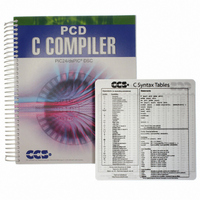PCDIDE COMPILER Custom Computer Services Inc (CCS), PCDIDE COMPILER Datasheet - Page 358

PCDIDE COMPILER
Manufacturer Part Number
PCDIDE COMPILER
Description
PCD C-COMPILER PIC24, DSPIC
Manufacturer
Custom Computer Services Inc (CCS)
Type
Compilerr
Datasheet
1.PCD_COMMAND_LINE_COMPILER.pdf
(373 pages)
Specifications of PCDIDE COMPILER
For Use With/related Products
Microchip PIC24/dsPIC®
Lead Free Status / RoHS Status
Not applicable / Not applicable
Other names
429-1008
- Current page: 358 of 373
- Download datasheet (4Mb)
Why does the .LST file look out of order?
The list file is produced to show the assembly code created for the C source code. Each C source
line has the corresponding assembly lines under it to show the compiler’s work. The following three
special cases make the .LST file look strange to the first time viewer. Understanding how the
compiler is working in these special cases will make the .LST file appear quite normal and very
useful.
1. Stray code near the top of the program is sometimes under what looks like a non-executable
source line.
Some of the code generated by the compiler does not correspond to any particular source line. The
compiler will put this code either near the top of the program or sometimes under a #USE that
caused subroutines to be generated.
2. The addresses are out of order.
The compiler will create the .LST file in the order of the C source code. The linker has re-arranged
the code to properly fit the functions into the best code pages and the best half of a code page. The
resulting code is not in source order. Whenever the compiler has a discontinuity in the .LST file, it
will put a * line in the file. This is most often seen between functions and in places where INLINE
functions are called. In the case of an INLINE function, the addresses will continue in order up
where the source for the INLINE function is located.
3. The compiler has gone insane and generated the same instruction over and over.
For example:
This effect is seen when the function is an INLINE function and is called from more than one place.
In the above case, the A=0 line is in an INLINE function called in four places. Each place it is called
from gets a new copy of the code. Each instance of the code is shown along with the original
source line, and the result may look unusual until the addresses and the * are noticed.
344
...........A=0;
03F:
*
46:CLRF
*
051:
*
113:
15
CLRF
CLRF
CLRF
15
15
15
Related parts for PCDIDE COMPILER
Image
Part Number
Description
Manufacturer
Datasheet
Request
R

Part Number:
Description:
PROTOTYPING BOARD FOR PIC MCU
Manufacturer:
Custom Computer Services Inc (CCS)

Part Number:
Description:
Extra CCS C Manual
Manufacturer:
Custom Computer Services Inc (CCS)

Part Number:
Description:
MACH X Programmer
Manufacturer:
Custom Computer Services Inc (CCS)

Part Number:
Description:
PCD For 24-bit (PIC24/dsPIC)
Manufacturer:
Custom Computer Services Inc (CCS)

Part Number:
Description:
LOAD-n-GO Programmer
Manufacturer:
Custom Computer Services Inc (CCS)

Part Number:
Description:
EMBEDDED INTERNET DEVELOPMENT KIT W/PCWH
Manufacturer:
Custom Computer Services Inc (CCS)

Part Number:
Description:
PIC24F Development Kit With PCWHD
Manufacturer:
Custom Computer Services Inc (CCS)

Part Number:
Description:
PIC24F Development Kit With PCDIDE
Manufacturer:
Custom Computer Services Inc (CCS)

Part Number:
Description:
PIC24H Development Kit With PCWHD
Manufacturer:
Custom Computer Services Inc (CCS)

Part Number:
Description:
USB Master Prototyping Board
Manufacturer:
Custom Computer Services Inc (CCS)










